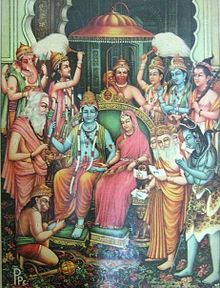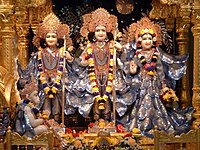Sita

Template:IndicText Sita (Sanskrit: सीता; "Sītā", Khmer: នាង សីដា?; Neang Sida, Malay: Siti Dewi, Indonesian language:Dewi Sinta,Thai: Nang Sida, Lao: Nang Sanda, Burmese: Thida Dewi, Tagalog: Putri Gandingan, Maranao Tuwan Potre Malaila Tihaia) is the wife of Rama, the seventh avatāra of Vishnu in the Hindu tradition. Sita is one of the principal characters in the Ramayana, a Hindu epic named after Her husband Rama.
She is esteemed as the standard setter for wifely and womanly virtues for all Hindu women. Understood theologically in Hinduism, Sita is an avatāra of Lakshmi, one of the forms of the Goddess or Shakti, who chose to reincarnate Herself on earth as Sita and endure an arduous life in order to provide humankind with an example of good virtues.
Legend
Sita was a foundling, discovered in a furrow in a ploughed field, and for that reason is regarded as a daughter of Bhudevi, the Goddess Mother Earth. She was found and adopted by Janaka, king of Mithila (present day Nepal) and his wife Sunayana. Since she was the princess of Mithila, she was (and is also) known as Maithili. Upon her coming of age, a swayamwara was held to select a suitable husband for her, and she was wed to Rama, prince of Ayodhya, an avatara of Vishnu.

Exile and abduction
Some time after the wedding, circumstances forced Rama to leave Ayodhya and spend a period of exile in the forests of Dandaka. Sita willingly renounced the comforts of the palace and joined her husband in braving the travails of exile, even living in Dandaka forest. However, she had to endure a lot of pain as the forest became the scene for her abduction by Ravana, King of Lanka. Ravana kidnapped Sita, disguising himself as a brahmana mendicant while her husband was away fetching a magnificent golden deer to please her. All this was done to claim vengeance on Rama and his brother Lakshmana for having cut off the nose of Ravan's sister. Jatayu, the vulture-king, who was a friend of Dasrath (Rama's father), tried to protect Sita but Ravana chopped off his wings. Jatayu survived long enough to inform Rama of what had happened.
She is finally rescued by Rama, who waged a famous battle to defeat Ravana. Since Sita was kept in captivity by Ravana all this time, she had to go through the 'Agni-Pariksha', the test of going through the fire, in order to prove her chastity to the world. Several historians claim she was pushed to the fire and was burnt to death. The Thailand version of the Ramayana, however, tells of Sita walking on the fire, of her own accord, to feel clean, as opposed to jumping in it. She is not burnt, the coals turn to lotuses. Walking on live coals is still a common custom in the South of India.
In Hindu dharma, every action has results irrespective of the stature of the person. A school of thought states that Rama questioned Sita on her integrity as a punishment for her questioning the integrity of Lakshmana, who had left all his comfort and served Rama and Sita for 14 years.
Later life
The couple returned to Ayodhya, where Rama was crowned king with Sita by his side. While Rama's trust and affection for Sita never wavered, it soon became evident that some people in Ayodhya could not accept Sita's long captivity under the power of Ravana.
Sita's second exile

During Rama's period of rule, an intemperate washerman, while berating his wayward wife, declared that he was "no pusillanimous Rama who would take his wife back after she had lived in the house of another man". This calumnious statement was reported back to Rama, who knew that the aspersion cast on Sita was entirely baseless. Nevertheless, his position as the ruler undermined by the ever-present possibility of slander attaching itself to his hitherto unimpeachable dynasty and personal reign. It was this train of thought that led Rama to remove Sita from his household.
Sita was thus forced into exile a second time; she was not only alone this time but also pregnant. She was rescued by the sage Valmiki. He gave her refuge in his hermitage, where she delivered a son named Lava. One day Sita left her son with Valmiki, and went to the river bank to fetch water. Valmiki called out for the baby but heard no response; in a state of concern, he created by his ascetic power another baby with kusha (grass) in the exact resemblance of Lava. When Sita returned, She found two sons of the same virtue because Lava came back from the forest on hearing his mother call out. She heard the story from Valmiki about why he had to create Kusha and accepted both sons as her own.
In the hermitage, Sita raised her sons alone, as a single mother.[1] They grew up to be valiant and intelligent, and were eventually united with their father. Once she had witnessed the acceptance of her children by Rama, Sita sought final refuge in the arms of her mother Bhumidevi, the Goddess Mother Earth. Hearing her plea for release from an unjust world and from a life that had rarely been happy, the earth dramatically split open; Bhumidevi appeared and took Sita away to a better world.
Significance
The actions, reactions and instincts manifested by Sita at every juncture in a long and arduous life are deemed exemplary; Her story, Sitayanam[2] is one by which every young girl in India is raised to this day. The values that She enshrined and adhered to at every point in the course of a demanding life are the values of womanly virtue held sacred by countless generations of Indians.
A female deity of agricultural fertility by the name Sita was known before Valmiki's Ramayana, but was overshadowed by more well-known goddesses associated with fertility. According to the Ramayana, Sita was discovered in a furrow when Janaka was plowing. Since Janaka was a king, it is likely that plowing was part of a royal ritual to ensure fertility of the land. Sita is considered to be the child of the earth, produced by the union between the king and the land. Sita is a personification of the earth's fertility, abundance, and well-being.[3]
Sita's speeches in the Ramayana
While the Ramayana mostly concentrates on Rama's actions, Sita also speaks many times during the exile. The first time is in the town of Chitrakuta where she narrates an ancient story to Rama, whereby Rama promises to Sita that he will never kill anybody without provocation.
The second time Sita is shown talking prominently is when she speaks to Ravana. Ravana has come to her in the form of a Brahmin and Sita tells him that he doesn't look like one.
Some of her most prominent speeches are with Hanuman when he reaches Lanka. Hanuman wants an immediate meeting of Rama and Sita, and thus he proposes to Sita to ride on his back. Sita refuses as she does not want to run away like a thief; instead she wants her husband Rama to come and defeat Ravana to save her.
When Rama wins the war, Hanuman goes to Ashok Vatika to give this news to Sita, and asks for permission to kill the female Rakshasas who have tortured her. Sita tells Hanuman an ancient story known as Na parah paap ma adate (Do not follow the sins committed by others) - one should behave according to one's dharma (righteousness) even if another has done you wrong.
Once she speaks badly to Lakshmana when he does not go after Rama to save him, but in a later part of the story she repents this.
Epithets

In common with other major figures of epic literature, Sita is known by many epithets. As the daughter of king Janaka, She is called Janaki; as the princess of Mithila, Mythili or Maithili; as the wife of Raama, She is called Ramaa. Her father Janaka had earned the sobriquet "Videha" due to his ability to transcend body consciousness; Sita is therefore also known as Vaidehi (Vaidehi Vaydehi, or Vaithegi) (Sanskrit: वैदेही)).
Etymology of the name
She is of course best known by the name Sita, derived from Seet (hindi), which literally means furrow. It is believed that her father Raja Janaka found her while ploughing as a part of a yagna.The word furrow was a poetic term in ancient India, its imagery redolent of fecundity and the many blessings coming from settled agriculture. The Sita of the Ramayana may have been named after a more ancient Vedic goddess Sita, who is mentioned once in the Rigveda as an earth goddess who blesses the land with good crops. In the Vedic era, She was one of the goddesses associated with fertility. A Vedic hymn recites:
Auspicious Sita, come thou near;
We venerate and worship thee
That thou mayst bless and prosper us
And bring us fruits abundantly.
The Kausik-sutra and the Paraskara-sutra associates Her repeatedly as the wife of Parjanya (a god associated with rains) and Indra.
Other legends
Two other legends obtaining in certain versions of the Ramayana may be mentioned in connection with Sita. These legends are significant in that they do not endorse the mainstream view of Sita having been an avatara of the goddess Lakshmi.
Vedavati
Some versions of the Ramayana suggest that Sita was a reincarnation of Vedavati (an avatar of Mother Laxmi), an orphan lady. The legend goes thus:
Sage Kushadhwaja was a learned and pious scholar residing in a remote hermitage. His daughter Vedavati grows up in her father's hermitage to become an ardent devotee of Vishnu, and resolves early in life to wed no one other than Vishnu. Her father refrains from stifling her aspirations, and even rejects proposals from many powerful kings and celestial beings who seek his daughter's hand in marriage. Among those rejected is Sambhu, a powerful Daitya king. Smarting under his humiliation, Shambhu seizes an opportunity and murders Vedavati's parents on a moonless night.
Vedavati continues to reside at the hermitage of her parents, meditating upon Vishnu. She is described as being inexpressibly beautiful, dressed in the hide of a black antelope, her hair matted, the bloom of her youth enhanced by her austerities. Ravana, the ruler of Lanka, once finds Vedavati seated in meditation and is captivated by her beauty. He propositions her and is rejected. Ravana mocks her austerities and her devotion to Vishnu; finding himself firmly rejected at every turn, he tries to molest Vedavati, pulling her hair.
Her chastity thus sullied beyond redemption, kedar immolates herself on a pyre, vowing to return in another age and be the cause of Ravana's destruction. She is duly reborn as Sita, wife of Rama, and became the direct cause of Ravana's destruction at his hands. In the process, Vedavati also receives the boon she so single-mindedly sought: Vishnu, in his avatara as Rama, becomes her husband. In some versions of the Ramayana, sage Agastya relates this entire story to Rama.
Valmiki wrote "The Ramayana", an ancient Sanskrit epic thought to have been compiled between approximately 400 BCE and 200 CE "The Ramayana" does not mention Sita as Ravana's daughter.However, the other versions of ramayana started recreating stories telling sita as daughter of ravana and have their own explanation of why sita was ravana's daughter.
Temples
See also
References
- ^ "Contemporary Influence of Sita" by Anju Bhargava [1];
- ^ "Sitayanam - A Woman's Journey of Strength" by Anju P. Bhargava;
- ^ Kinsley, David (1986, pp.65-80). Hindu Goddesses: Visions of the Divine Feminine in the Hindu Religious Tradition. Berkeley, University of California Press.
Further reading
- Hindu Goddesses: Vision of the Divine Feminine in the Hindu Religious traditions (ISBN 81-208-0379-5) by David Kinsley
- The Ramayana (2001) by Ramesh Menon


